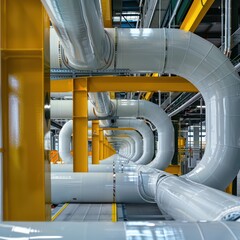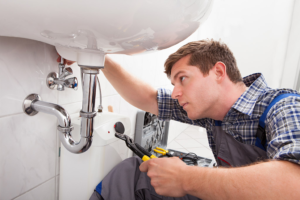Epoxy Pipe Lining is an excellent option for sewer lines, drains, water pipes, heat and A/C ducting. Its slick inner liner increases flow and reduces blockages.

It is also a less invasive method of restoration than traditional pipe replacement. It eliminates leaks and infiltration without tearing down walls or excavating the ground.
The plumbing pipes in any building are a vital part of the infrastructure. These pipes transport water and waste, as well as heat and cold. Unfortunately, these pipes can corrode over time. When this happens, it puts the building at risk of structural damage and may even compromise the safety of the people in it. However, it is possible to rehabilitate corroded pipes with epoxy pipe lining. This technique can be cheaper than traditional pipe replacement and is highly effective.
The best thing about epoxy pipe lining is that it is an in-place pipe repair method. This means that you won’t have to dig trenches around your home or business. Instead, a technician will access the old pipes through existing access points such as cleanouts. The lining process involves spraying the epoxy resin inside of the existing pipes. The epoxy will mold itself to the surface of the pipe and fill any cracks or gaps.
Although the epoxy can delaminate over time, it is still a more sustainable option than traditional repiping. It is also a safer option since you won’t have to worry about chemical leaching into your drinking water.
Another benefit of epoxy lining is that it can help to reduce the number of leaks in your pipes. This is because the epoxy coating prevents water from leaking out of the walls of your pipes. This will save you money on your water bill and make your pipes more durable.
In addition to reducing the number of leaks, epoxy lining can also help to reduce the amount of water that is lost due to corrosion in your pipes. It can also increase the flow of water through your pipes, making them more efficient. Finally, epoxy lining can improve the quality of your water by removing contaminants from your pipes.
Although traditional repiping is more expensive than epoxy lining, it offers many benefits that can offset the initial investment. For example, it can prevent health problems caused by corroded pipes, such as lead and copper leaching into your drinking water. In addition, it can increase the resale value of your home.
Pipe Corrosion Prevention
Pipe corrosion is an extremely serious problem that has a wide range of harmful effects. It can lead to water leaks, structural damage, and even health issues. If left unchecked, it can also cause major repairs and replacement costs. Fortunately, there are a few ways to prevent this issue. One of the most effective is by using epoxy pipe lining. This method is used to repair and protect pipes from corrosive chemicals.
Unlike traditional repiping, this method does not require digging up the entire piping structure to access corroded areas. It also reduces the time and money required to dig up and restore the entire plumbing system. Furthermore, it can help save you the headache of dealing with construction contractors and relocating your utilities.
The slick inner coating of the epoxy liner increases flow inside the pipeline and minimizes the risk of blockages. It can be applied to water pipes, sewer systems, and even heat and A/C ducting. This makes it suitable for a variety of commercial, residential, and industrial projects.
This method is also environmentally friendly. The process uses no solvents or acids, which reduces environmental impact and waste production. In addition, it has a low upfront cost and can last for half a century or more. It can also be used to protect old pipes from future damage or leaks.
However, there are a few drawbacks to epoxy lining. First, it is not easy to repair if a leak occurs in the future. This is because the epoxy cannot take the heat of a torch, so plumbers have to use a special tool that cuts into the pipe. The epoxy can then delaminate and expose the interior of the pipe to corrosion, resulting in a leak and further damage.
In addition, the epoxy lining can crack or peel off over time. This is caused by poor cleaning of the pipes before the lining is installed or improper installation. It can also be caused by the degradation of the lining itself. When this happens, the lining can leak or develop holes and create a host of other problems.
Pipe Maintenance
Pipe corrosion is not a problem that can be ignored, as it increases the risk of property damage and water infiltration, which can result in structural damage and health issues for building residents and customers. Fortunately, it is possible to prevent internal pipe corrosion by regularly maintaining the pipes using epoxy coatings.
Epoxy coatings are a non-toxic solution that can be used to coat the interior of old and damaged pipes, protecting them from future damage and leakage. This method is a much less expensive and environmentally friendly alternative to traditional pipe repair methods, such as trench excavation and replacement. It also reduces the need for costly and time-consuming demolition, which is often required when repiping is necessary.
This pipe repair technique can be used for a variety of applications, including sewers and drains, water pipes, heat and A/C ducting, and electrical conduits. The slick inner coating allows for increased flow within the pipes and helps to prevent blockages, which are caused by corrosion and buildup of debris. The coatings are also lead-free and corrosion resistant, which makes them an excellent choice for potable water pipes.
The process of applying an epoxy coating is similar to CIPP, but it is less invasive and doesn’t require as much equipment. This is ideal for large commercial and residential buildings with aging pipes that need to be repaired or replaced.
Before an epoxy coating is applied, the existing pipes must be evaluated through sewer camera inspection to determine if they are suitable for coating. If they are, the pipes must be cleaned to remove any debris or build-up that could affect the lining process. This is done with hydro jetting to ensure the pipes are completely clean and ready for the new coating.
After the pipes have been cleaned, they are coated with an epoxy resin that is designed for potable water systems. The epoxy coatings are cured in place to create a strong, durable inner coating that prevents further corrosion and leakage. The resulting liner is safe to use for drinking water, and can last up to 50 years.
Cost
Epoxy pipe lining is significantly less expensive than traditional plumbing repairs and repiping. This method saves you the cost of tearing down walls and floors in order to access pipes, which can be very expensive. The plumbing industry refers to this process as trenchless because it avoids the need for large excavation or demolition projects. It also eliminates the need for shutting down facilities and requiring you to move out of your building while the work is being done.
In most cases, epoxy liners can be installed using existing access points, like cleanouts. If these are not available, new access panels can be created and hidden inside a wall. This will make the whole project much quicker and easier. It will also be a lot less expensive than digging up and replacing the entire pipe system.
A traditional repipe operation can require four weeks for the work to be completed and can result in water being shut off for this time period. This can create a significant inconvenience for you and your business or facility, especially if the water is used to make food. In addition, the area will be off limits to you and your employees, so you must find alternative ways to get your work done.
The CIPP technique of epoxy lining can be applied in a few days. However, you must have a plumber who is qualified to perform the service and has experience in this particular procedure. Proper installation is critical, and it must be performed correctly to ensure the liner stays in place and does not delaminate.
It is important to have your pipes professionally cleaned before the epoxy lining procedure is applied. This will help ensure the epoxy coating adheres properly to the inside of your pipes, and it will protect against future corrosion and leaks. It is also crucial to remove any scale build-up, which could cause the epoxy lining to crack or fail.
You must also be aware that the epoxy coating may not be compatible with certain chemicals, such as those in hydronic piping systems. This can cause chemical reactions that affect the functionality of the system, and they can even result in a ruptured pipe.
